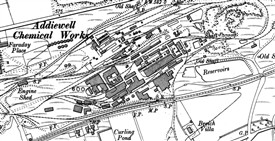A tour of Addiewell Oil Works in 1865

Addiewell Oil Works in 1922
Ordnance Survey, 1922 edition.
Site of the Addiewell Oil Works
A detailed account of the oil works appeared in the Scotsman in May 1865
On 16 May 1865, the Scotsman newspaper published a detailed account of the Addiewell Oil Works. It's particularly interesting as the works was just in the process of being built.
The works, 'when completed, will be the largest in the kingdom...' 'The works are at present only in the preliminary stage of construction, but they are being pushed forward with vigour, and it is expected that by the autumn they will be well advanced. The new manufactory is being built on the estate of Addiewell.'
'Wooden huts whence proceed mingled sounds of labour, denote that the artificers [workmen] are already industriously intent in executing the many preliminary operations necessary to the commencement of an extensive enterprise.... The works are to be divided into two almost equal parts by a broad open way running like a street down the centre. Down this street at branch line of railway will be led, upon which a small steam locomotive will be placed.... One great advantage of this will be to enable Mr Young to transport shale direct from his own coal-pits at [Bathgate] to [Addiewell] when occasion requires.'
'About 200 men are employed at West Calder pushing forward the works. A larger number would be engaged... were it not for the limited house accommodation in the neighbourhood. The village is very small and every available lodging has been taken possession of. The opening of four or five coal pits which was the first step taken by Mr Young... brought an unexpected influx of pitmen into the district. Subsequent arrivals of masons, brickmakers, joiners, blacksmiths, and labourers taxed to the utmost the accommodation which the cottages of the hamlet provided, and it was consequently found to be somewhat difficult to induce men to come to a locality where they could not get themselves properly housed. To remove this obstacle, Mr Young addressed himself at the outset. A long row of neat brick cottages was erected without delay upon his own estate, and these have been given over to the skilled mechanics employed at the works. In addition to these, two rows of commodious wooden huts, capable of accommodating about 130 men, have just been completed and taken possession of by the navvies. A good many cottage and houses have also been recently built at the village to meet the want that existed and which promises to be soon renewed.'
The article goes on to describe the brickworks, the shale and coal pits, and a detailed description of the processing of shale in the oil works. The article concludes with promoting the idea that the ships of the Royal Navy should run on oil, not coal - a proposal that came to pass in the early years of the 20th century. For some 20 years, the Royal Navy sailed the oceans fuelled by West Lothian shale oil.
'[Shale] production will ever take rank as one of the most wonderful of modern inventions, and the good qualities of the oil will always be valued by all who do not love darkness rather than light.'